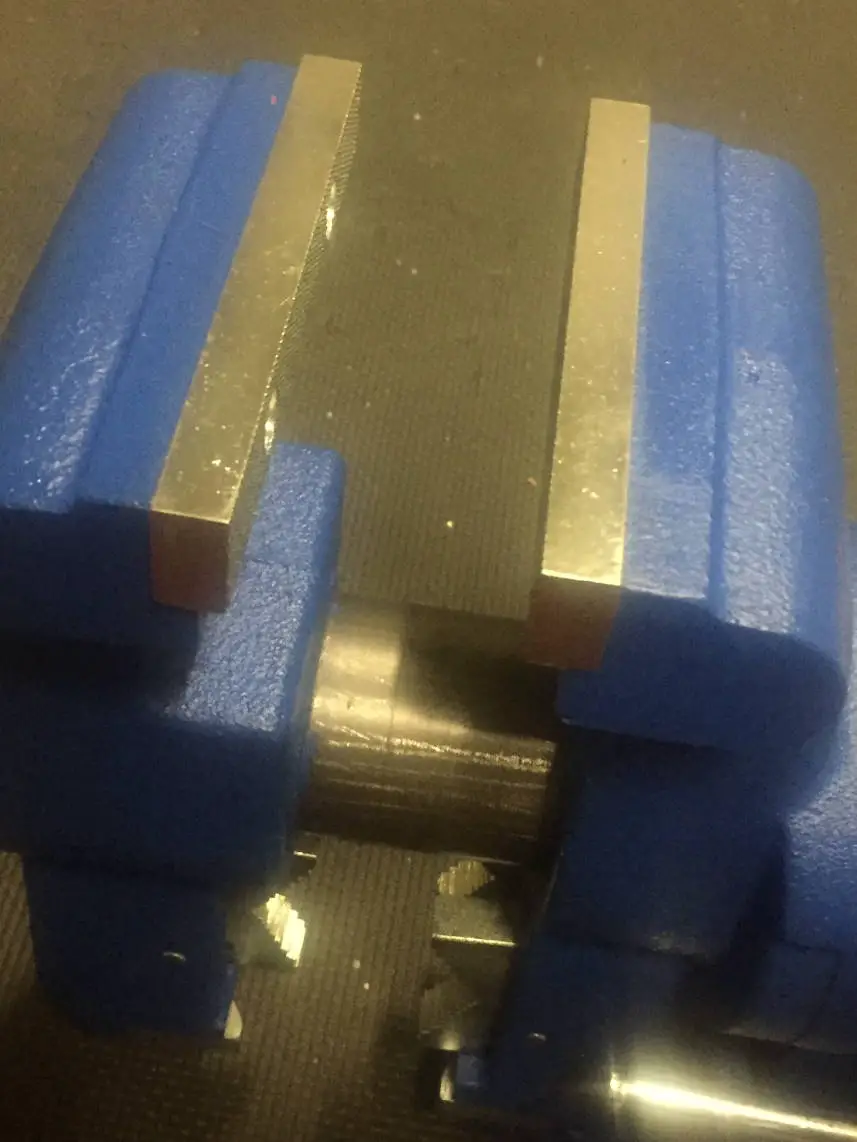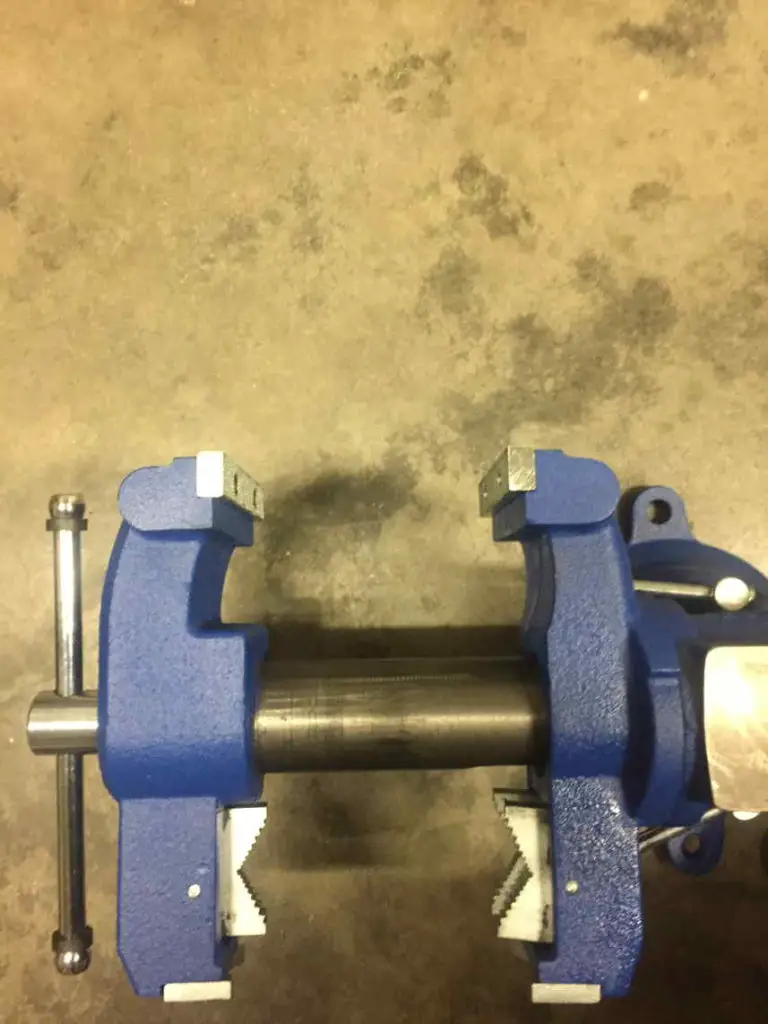
The bench vise – also known as a mechanics vise, workshop vise, machinist vise, or engineers vice** – is one of the most fundamental tools in a workshop.
** What is The Difference Between Vice and Vise?
There are some differences between the various english speaking countries as to how these tools should be spelled. In my humble opinion, a vice is an immoral or undesirable practice. A vise is a gripping or grasping tool. It’s not a hill I”m willing to die on, but I thought I should explain why I included both spellings in this article as people search for both versions of the word.
What Are The Different Parts Of A Vise?
There are two Jaws on a vise: one is fixed and the other moves parallel along a screw via a replaceable nut.
Most vises are named according to the width of the jaw, not the opening length.
Most default jaws come with a serrated edge of hardened steel to improve grip and to improve the durability of the jaws. You can buy jaws that are smooth, and you can buy jaws that are soft if your work requires it.
If you need a soft touch for a one off job, you can buy grips that fit over the face of the jaw edge. These are made of a softer material such as aluminum, wood, copper or plastic. Soft vice jaw grips can help prevent you from damaging or imprinting your stock with the serrated edge. The soft grips are sometimes called cheeks.
Fun fact, old jaw grips made prior to the 60’s were often made of lead. This practice was discontinued due to the toxic nature of the material.
What Makes A Good Vise?
If you know what size stock you will be working with, it’s important to note things such as jaw length,opening length, and throat length. You want to make sure you have a vice big enough for the work you are doing
You must also think of things such as clamp strength, and the vises ability to withstand impact damage. A lot of cheaper vises will break if you are too rough on them. Repairing broken vises takes time, and replacing them takes money. So it’s worthwhile in my opinion to avoid the cheapest vises on the market as you will pay later down the road in other ways.
Another factor is whether or not you should get a swivel vice – see more below.
Are Swivel Vises Worth It?
In my opinion swivel vises are easier to break if you are rough with them. So while swivel vises are very convenient for daily use, I wouldn’t buy a cheap one if you are going the swivel route as swivel vises are (relatively) easy to break.
Put simply: fixed vices are more solid.
3 Best Bench Vises For Sale
Budget option: yost 905-AS 5”
This is a pretty sturdy vise if you are looking for a cheaper option. It can break if you abuse it, but it should hold up for most small home workshop jobs. It comes in a number of jaw sizes including 4”, 5”, 6” 8”, 10”. All jaw sizes are made with hardened steel. It has a pipe capacity of ½” to 1-½” with grooved pipe jaws for better grip. It has a 360-degree swivel base and has a 60,000 PSI structural cast steel body.The jaws are replaceable and the 5” version weighs 24 pounds.
I like this vise over other budget options as it has the 60,000 PSI cast steel body. A lot of cheaper vises will have a structural body made of 30,000 PSI cast iron and this stuff is straight junk.
Best Middle Tier Bench Vise
This vise is more expensive than the previous version, but it is quite a bit more robust as well. According to the store page, the 5” vise has a casting clamp force of 12,300 lbs and a Torque rating of 290Ft-Lb.
It is made from high strength 130,000 PSI Austempered Ductile Iron castings – aka, the good stuff. The 5” vise has 6” throat depth and pipe capacity of 3.25”. It has a 360-degree swivel base and contains a .75”D acme thread for it’s primary spindle. It has replaceable hardened steel serrated top jaws and pipe jaws.
Overall this is a great vise for people who are expecting to put their vise to heavy use, but are not expecting to use their vise for a high volume industrial/commercial operation.
Best Heavy Duty Bench Vise
For the Best Heavy Duty Bench Vise I would recommend the Yost ADI-8 model. It is similar to the model above, but it is much larger and sturdier with a larger clamping force. It is made of the same high quality materials as the ADI 5.
You can of course go and buy a vise that costs several thousand dollars. These vises were made to be beat up on. But I’m not going to review any of them, as I’m sure 99% of the people reading this are not interested in those vises.
Best All Purpose Bench Vise: Yost 750-DI
This vise has a rotating jaw which sits on top of a swivel base. The vise head rotates 360 degrees with respect to the vertical, and locks every 30 degrees making for 12 different locking points. It has a jaw opening of 5” and a throat depth of 4”. It has a pipe capacity of .125”D x 3.5”D and has special jaws just for pipe.
This makes it a great all around vise as it can handle a wide variety of situations you may encounter in the shop.
It is made with 65,000 PSI Ductile Iron and has a casting clamp force of 13,400 lbs and a torque rating of 316 Ft-Lb. It has a .75”D main screw made out of Q235 steel and a .51”D x 9.5” handle.
This is a flexible vise made of high quality materials.
However, all this optionality isn’t free. In my mind, the ability to rotate the vise at two points has a cost in that it introduces more points of failure. I wouldn’t not beat the crap out of this vise, as I imagine those rotation points will come at the cost of the ability to absorb shock blows. A vise without all these rotating capabilities will have fewer parts that can break.
But don’t let that scare you away, the fast majority of people should not have issues with this vise, and the flexibility offered by rotating jaws and the swivel base is worth it.

19 Different Types Of Vises
There are a number of different types of vises. Some of these vises are just small variations of a general theme, and others are radically different and only used in niche cases.
- Hand Vise
- Compound Slide Vises
- Cross Vises
- Off-Center Vises
- Angle Vises
- Sine Vises
- Rotary Vise
- Suction Vise
- Diemakers Vise
- Saw Vise
- Pin Vise
- Jewellers vises
- Fly Tying Vise
- Leg Vises
- Trailer Hitch Vise
- Shaker Broom Vise
- Rigging Vise
- Chain Vises
- Yoke Vises
Some vises are sold as having “quick release valves.” These vises employ a split nut that allows you to disengage the vise with a half turn of the handle, greatly speeding up some production processes.
When Was The First Vise Produced?
According to this source, the first parallel vise was made in 1750. According to the same source, the first cast iron vise was made in 1830. Prior to that, many craftsmen used a variety of wedges and primitive clamps to hold work in place.
What Are Bench Vises Used For?
Bench vises are used to hold a piece of stock in place while additional work is done to said stock. Examples of such work include filing, grinding, sawing, chipping, and glueing.
What Material Is A Bench Vise Made Out Of?
Most bench vises are made out of cast steel or cast iron. High quality vises are made out of ductile iron.
Where On Your Bench Should You Install Your Bench Vise
It’s best to install your bench vise on the corner of your work table with the stable jaw jutting out over the edge of the table. This prevents your table from blocking your workpiece when the jaws are vertical, and allows maximum freedom of placement of your stock around the vise.
How To Use A Bench Vise
A bench vise is an easy to use tool. Simply turn the handle / tommy bar and this will open or close the jaws by turning a nut around an internal threaded screw. Be wary of hitting the handle to further tighten the jaws and be wary of using a cheater bar to further tighten a vise as this will break the vast majority of cheap vises.
How to Calculate The Mechanical Advantage Of A Vice Screw
To calculate the mechanical advantage of a vise screw, you simply take the circumference of a circle (2* π *r) and divide by the screw pitch length to get your mechanical advantage.
Example: Lets say you have a 6 inch handle turning a screw with a pitch of 1/4in. Multiply (2 * π * 6) and divide it by .25 and you get around 150! Of course some of this is lost to friction.